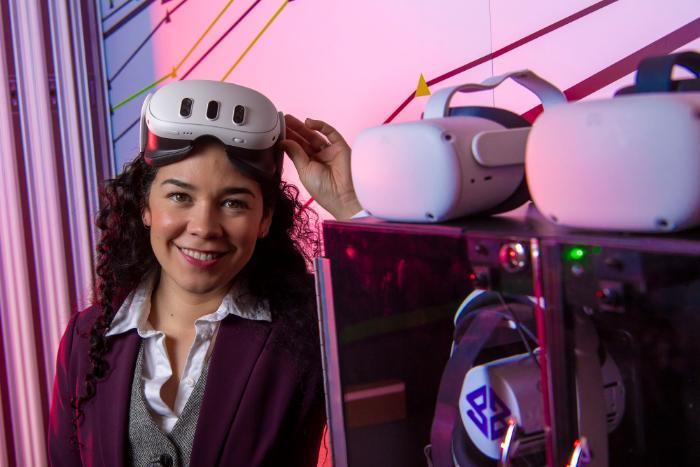Introducing Dr Julie Williamson
Dr Julie Williamson is a computing scientist working on modelling and analysing how we experience immersive realities together.
Tell us about yourself
I first came to The University of Glasgow as a PhD student in 2008, researching the social factors that influence how we adopt new and unusual technologies. I’ve worked with gesture control, speech input, spherical displays, shape changing displays, and now immersive displays.
My research has always been motivated by the tension between what new technologies are capable of and what people are willing or able to do with them. We can create functional, exciting and important new interaction devices, but if people are not willing to accept them in real world contexts these technologies won’t be adopted.
I’ve been working with immersive devices since 2018, when I began looking at the social acceptance of virtual reality in public places like airplane travel, work environments, and festivals. I take a mixed-methods approach to understanding how people behave and interact with immersive technologies, combining traditional qualitative data with quantitative techniques to generate new models for social immersive experiences.
My main approach utilises “social signal processing,” which treats the social signals we give off constantly like proximity, position, and gesture, as quantitative digital signals. The most interesting aspect of this work focuses on interpersonal signals, which only exist when two or more people interact. So rather than gesture recognition, I look at whether our gestures are synchronising or we’re pointing at the same thing. These interpersonal signals form the basis of how I model and analyse social interactions in immersive environments.
How would you describe your research interests and current work?
My research focuses on understanding how we experience immersive realities together, and how we can use that knowledge to design experiences that are more productive, enjoyable, and meaningful.
We’ve all been through a hybrid meeting or hybrid event that just doesn’t work. Reality and virtuality currently compete for attention, causing significant friction, disruption, and interpersonal conflict. Virtual experiences are plagued by missing and incomplete social signals, felt keenly in settings like Zoom where incomplete social signals force the mind to fill the gaps causing exhaustion. Physical experiences are disrupted when attention is diverted to the virtual, and vice versa. The tension when moving between reality/virtuality can be jarring and exhausting.
There is a rich and continuous stream of data from interpersonal social signals across reality/virtuality, but there are not yet models or techniques to leverage these signals for social interaction in immersive realities. My work aims to develop the models needed to make interaction in hybrid immersive realities feel good and work as smoothly as face-to-face experiences.
What would you most like people to know about you?
Open science is a fundamental part of my research philosophy. I believe that open science is much more than just sharing data. We should aim to be transparent and open about all aspects of our research, from ideation and design to analysis and dissemination.
As part of this ethos, I recently shared my unsuccessful and successful applications leading to my ERC Consolidator award to de-mystify the proposal process and uncover the series of failures that go into an eventually successful proposal. Rejection and failure are an inevitable part of doing research and pursuing ambitious ideas, and I think it’s important to be open about this process, to talk candidly about failure, and share our ideas openly.
What do you like most about working in the ARC?
I recently moved to the ARC, and this feels like such a natural home for my interdisciplinary research. My research makes extensive use of the ARC-XR Lab, which has unique capabilities in the UK and possibly the world. This lab, with its repeated cube layout, makes data collection for physical, virtual, and hybrid social experiences possible and enables new research not feasible elsewhere.
As my ERC Consolidator Grant ramps up in data collection, we’ll be pushing the boundaries of what is possible in XR using the ARC-XR Lab. Being close to the lab and surrounded by colleagues from different disciplines creates a perfect context for doing innovative work in immersive technologies.


